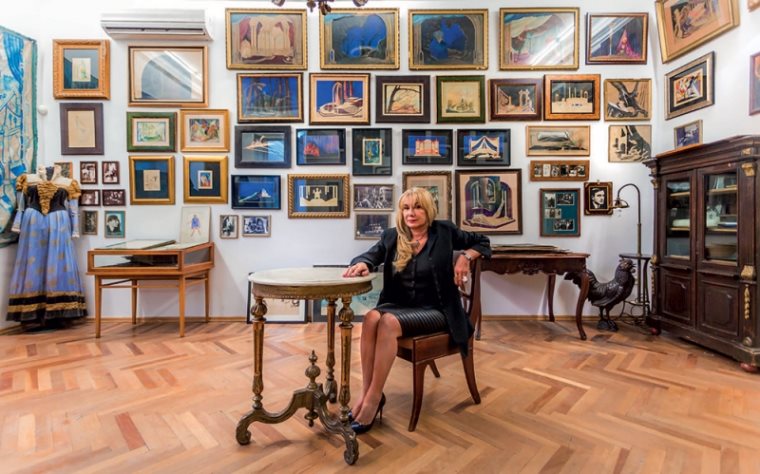Starting her business from scratch 27 years ago, Khatuna Melikishvili became one of the first gallerists in Georgia. Today she owns three galleries of her own – Gamrekeli Gallery on Ingorokva Street, Gamrekeli Bagebi and Design Gallery Gamrekeli. The artwork she has collected over the years is now worth over five million dollars.
I met with Khatuna Melikishvili in the Irakli Gamrekeli House Museum. Irakli Gamrekeli is a famous Georgian painter, as well as a theater and cinema artist. He is also one of the founders of Georgian avant-garde scenography. Signs of expressionism and art nouveau make him look more distinguished from the others. The walls of his house are dotted with the artwork of various painters, and the atmosphere is comfortable to have a conversation. Ingorokva Street 14 is where Irakli Gamrekeli lived in the 1930s. Today, the space has been transformed into a gallery. The place is loaded with theatrical paintings, decorations, and the painter’s private library. The gallery is divided into two parts: a museum and an exhibition area, which is mostly devoted to modern art. We sat in the museum for our interview, as on this day they were preparing for an exhibition, as young artists were busy arranging their artwork and adjusting the lighting inside the exhibition space.
Aside from the paintings in the room, some old theatrical costumes were also displayed throughout. However, my attention was immediately drawn to the ancient chairs and tables in the room, which I wanted to ask more about, but we didn’t have much time, so we got straight down to business. When I asked Melikishvili how she got into the field she is in, Melikishvili said that she had little control over that.
“That was determined before my birth. I was born into a family of scientists and artists. The National Museum of Fine Arts is named after my grandfather – academician Shalva Amiranashvili. I grew up with my grandfather and was surrounded by his books and belongings, and I loved them. These books, pictures and other works of art have different meanings for me and I’ve been around them since my childhood. In fact, if you ask me what color the walls of my home were as a child, I can’t give you an answer. That’s because all the walls of every room – from floor to ceiling – were filled with books and paintings,” noted Melikishvili.
Melikishvili graduated from two different faculties: the faculty of Art and the faculty of History. After university, she began working at the Institute of History. In 1988 together with her friend Nino Metreveli, she opened the Gallery of Modern Art – or ‘N Gallery’ as it was called. It was at that point that she became a gallerist.
“During this period, we were working with young painters who are now the leading artists in within Georgia’s modern fine art community. Artists like Oleg Timchenko, Ushangi Khumarashvili, Mamuka Tsetskhladze, Koka Ramishvili, Koka Tskhvediani, Niko Tsetskhladze and others,” she says.
Although Melikishvili avoids divulging her age, she proudly notes that she has been working in this field for 30 years. During this time she managed to become the owner of artwork that is now valued at several million dollars. Her husband David Shimshilashvili, also helps her, but most of the art she obtained before marriage. A large share of her collection consists of paintings by Parajanov and Gamrekeli. There are also several pieces of art in her collection that were created by modern artists.
“The right investment in art is always profitable. When you know the artist’s abilities, such an investment is very profitable and enjoyable by itself. Of course, in most cases you take risks, you don’t know whether or not the particular work will gain value over the years or not. Take for example Pirosmani, when he was a young contemporary, his works had no value. However, those who liked his work and bought them, eventually saw a return investment of several million. The wealth of the collector depends on time, you can call it a hobby or a passion, but the fact is, years later it can make you rich. For example, someone might have collected comic books, while others were reading them and throwing them away. The one who saved them eventually established a collection, now this “funny magazine” has a pretty high price because their number decreases over time, and they become relics. Accordingly, their price rises, and the item becomes an antique. In different countries, there are items of varying age, value and importance that are considered antiques. To some extent it depends on the life expectancy of the population. For example, in China, items could be considered antiques 100 years from now. Here in Georgia, any item older than 70 years is considered an antique.”
Melikishvili and her husband are not only collectors who buy artwork for their own pleasure, but they are investors who know that any amount invested in the world of art increases daily. Doing this job is easy for Melikishvili. She has contacts, knows a lot of people, and is well known herself. It’s not hard for her to see the difference between good and bad. She provides advice to people who are thinking about investing in what she calls the “wealth of the future”. According to Melikishvili, if you are interested in this field, you need to hire an art dealer. She compares her field of work with the stock exchange, and just as you need to have a broker on the stock exchange, in this business, you need an art dealer. Just like the stock market, the art market is focused on the sale, it’s just a different product. Here too, the marketing aspect of the business is the most important. For hours, curators and wealthy collectors deliberate over whether it is worth investing in piece of artwork or an artist or not.
“If a buyer decides to do it on his own, and he’s doing it via the internet, he has to review the history of the artist whose artwork he wants to buy. There is a book of ratings that indicate which place the particular artist is in – a ranking in other words. After this, we check the price of a similar piece of art that was sold on auction, and only after this can we buy the item.”
PRICE TIED TO NAMES
“Novice painters are the students of an academy or self-taught artists who organize exhibitions on their own initiative, using their own resources. In such cases you need to use intuition when deciding to buy a piece of art. It’s kind of like the casino: you never know when you will hit the jackpot. So, intuition is part of it, the advice of the professional is simply not enough,” Melikishvili explains.
“There are two main criteria when buying a piece of art. The first is that you like it and are fascinated by it of course. Secondly, you need to think about the future. So, if you can afford to purchase the art, buy it for your child or grandchild. I remember that at one time, a painting by Pirosmani was worth 2,000 Rubles. Now the piece sells for between 3-5 million dollars. The works of Gudiashvili were sold for a paltry 100-500 rubles, now his art sells for as much as one million dollars – some for even more. Georgians have always loved art, always respected artists. That‘s why so many good pieces of art are collected here. In fact, Georgia can boast of a lot of famous artists – Pirosmani, Gudiashvili, Kakabadze, Gabashvili, Zdanevich, Akhvlediani, Kobuladze, and Kikodze…The early works by these artists are estimated to be worth six-digit amounts. It is remarkable and pleasant that contemporary Georgian artists are developing very quickly and are relevant on the global art market. The artwork of modern artist Oleg Timchenko was sold at Bonham’s Auction for $15,000. With regard to Pirosmani, his last painting sold for ₾3.5 million.”
All of this begs the question: Can a novice artist put his work up for auction? What should he do? Does he need a counselor or someone to help him?
An auction is a live business, one that depends on relationships, contacts and even trust. Everyone has a connection to each other. Excitement, personal relationships and interests are involved here. So, to satisfy my interest, I asked Melikishvili to tell me everything about this.
“An auction needs a result. So, only artwork that is guaranteed to be sold is accepted. The art’s prestige comes from this. This is how the leading auctions work today – auctions like Christie’s, Sotheby’s, Bonham’s and so on. However, when world is in a crisis, this is when collectors purchase expensive artwork at the auctions. They know that during a crisis, the price of the painting rises,” says Melikishvili.
COMMERCIAL ASSESSMENT
“I remember about ten years ago, a banker came to me and expressed a desire to start an art collection. Obviously, the banker started with a small amount. My recommendation was to buy one painting. At the time, the painting was worth ₾1,000.Several years later, the painting was worth ₾50,000. Today, it’s not even on the market. So in terms of business, artwork can give us 300, 400, 500% profit. No other sector offers such a profit margin.”














